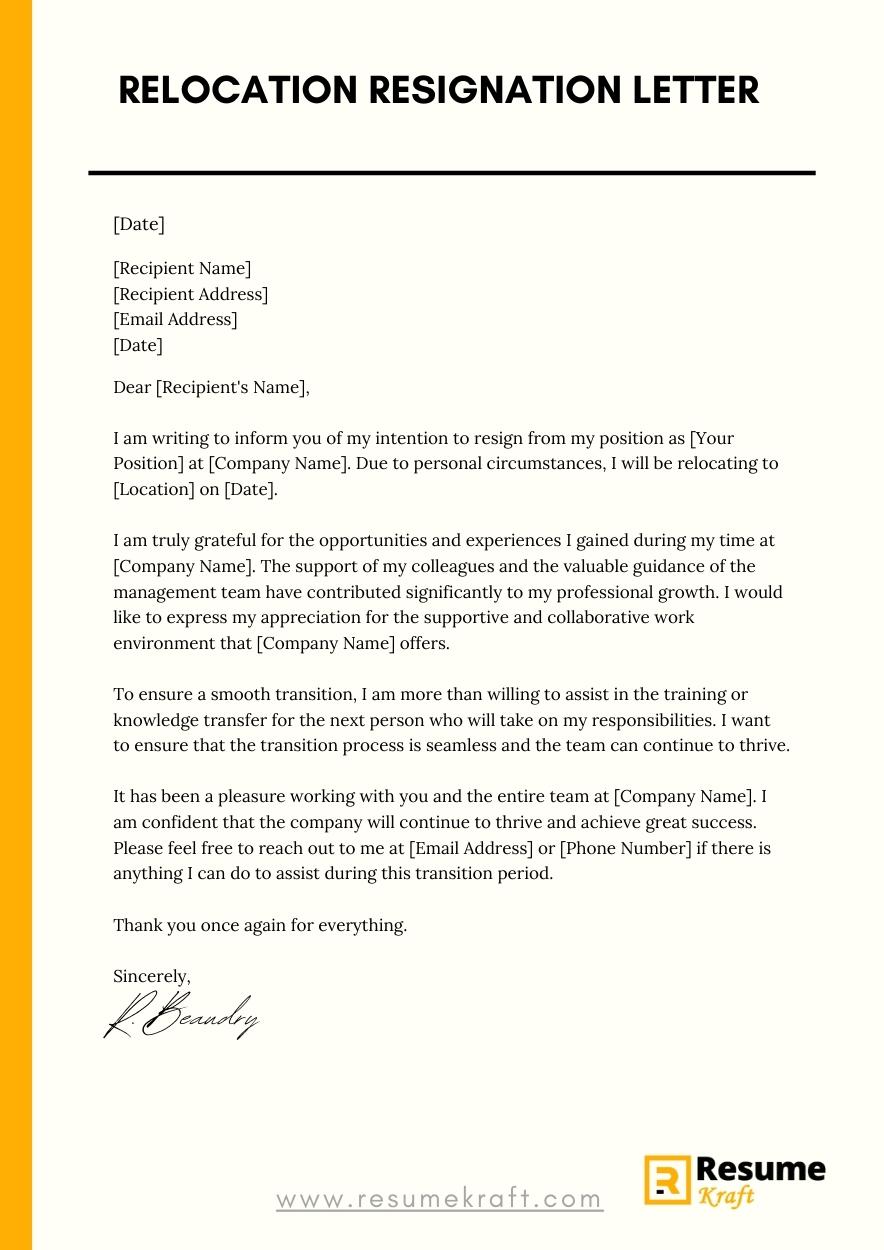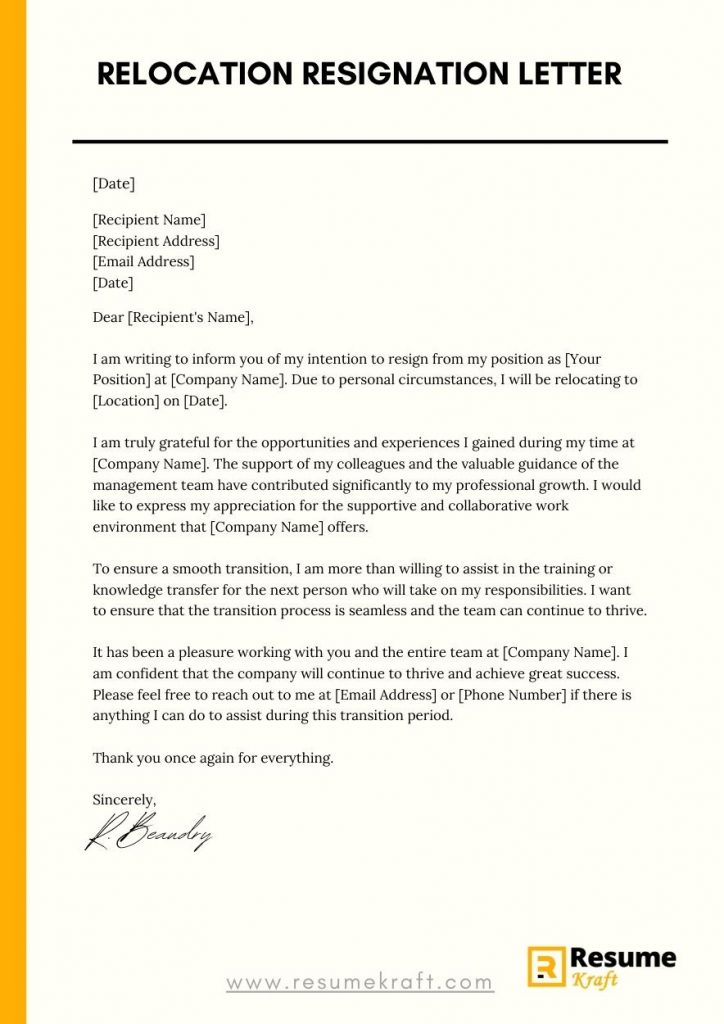
Are you faced with the difficult task of resigning from your job due to relocation? Writing a resignation letter in such circumstances can be challenging, but with the right guidance, you can ensure a smooth transition. In this comprehensive guide, we will walk you through the process of writing a relocation resignation letter step-by-step. We’ll also provide you with sample templates to help you structure your letter effectively.
- What To Include in a Relocation Resignation Letter
- What Not to Include in Your Relocation Resignation Letter
- How To Format a Relocation Resignation Letter
- Relocation Resignation Letter Samples
- Key Takeaways
- Frequently Asked Questions
- 1. What is a relocation resignation letter?
- 2. Why is it important to write a relocation resignation letter?
- 3. What should I include in my relocation resignation letter?
- 4. Should I explain the reasons for my relocation in the resignation letter?
- 5. Can I send my relocation resignation letter via email?
- Conclusion
What To Include in a Relocation Resignation Letter
When writing a relocation resignation letter, it’s crucial to include certain key elements to ensure clarity and professionalism. Here are the essential components to include:
- Salutation: Address the letter to your immediate supervisor or the appropriate person in your organization.
- Opening Paragraph: Begin by stating your intention to resign due to relocation and provide the date of your last working day. Clearly mention the reason for your relocation and express gratitude for the opportunities and experiences gained at the company.
- Transitional Statement: Offer assistance in ensuring a smooth transition by expressing willingness to help with the transfer of responsibilities or training a replacement.
- Appreciation: Express gratitude towards your colleagues, superiors, and the organization as a whole for the support and opportunities provided during your employment tenure.
- Closing: End the letter on a positive note by reaffirming your appreciation and leaving room for future networking opportunities.
- Contact Information: Include your updated contact information, such as your personal email address and phone number, so that your colleagues can stay in touch.
What Not to Include in Your Relocation Resignation Letter
While it’s important to include the necessary components, there are certain things you should avoid including in your relocation resignation letter. These include:
- Negative Remarks: Avoid criticizing the company, colleagues, or management in your resignation letter. Maintain a professional tone throughout.
- Personal Reasons: Unless relevant to your relocation, avoid sharing excessive personal details that may not be necessary for your employer to know.
- Regret or Doubt: Refrain from expressing regret or doubt about your decision to resign. Stay confident in your choice and focus on the positive aspects of your relocation.
- Long Explanation: Keep your letter concise and to the point. There is no need to go into extensive detail about the reasons for your relocation unless required.
How To Format a Relocation Resignation Letter
Proper formatting goes a long way in creating a professional impression. Here’s how to format your relocation resignation letter:
- Use a Professional Tone: Maintain a polite and professional tone in your letter. It should be formal but also convey gratitude and positivity.
- Choose a Clear and Legible Font: Use a standard font such as Arial or Times New Roman, with a font size between 10 and 12.
- Include Your Contact Information: Place your personal contact information (email and phone number) at the end of the letter for easy communication.
- Proofread: Double-check your letter for any grammatical or spelling errors. A well-proofread letter shows attention to detail and professionalism.
- Print or Send Electronically: Depending on your workplace culture, you can either print the letter and hand it to your supervisor or send it via email.
Relocation Resignation Letter Samples
To make the writing process easier for you, here are two samples of relocation resignation letters:

Printed Resignation Letter Sample
[Your Name]
[Your Address]
[City, State, Zip Code]
[Email Address]
[Phone Number]
[Date]
[Supervisor’s Name]
[Company Name]
[Company Address]
[City, State, Zip Code]
Dear [Supervisor’s Name],
I am writing to inform you of my intention to resign from my position as [Your Position] at [Company Name]. Due to personal circumstances, I will be relocating to [Location] on [Date].
I am truly grateful for the opportunities and experiences I gained during my time at [Company Name]. The support of my colleagues and the valuable guidance of the management team have contributed significantly to my professional growth. I would like to express my appreciation for the supportive and collaborative work environment that [Company Name] offers.
To ensure a smooth transition, I am more than willing to assist in the training or knowledge transfer for the next person who will take on my responsibilities. I want to ensure that the transition process is seamless and the team can continue to thrive.
It has been a pleasure working with you and the entire team at [Company Name]. I am confident that the company will continue to thrive and achieve great success. Please feel free to reach out to me at [Email Address] or [Phone Number] if there is anything I can do to assist during this transition period.
Thank you once again for everything.
Sincerely,
[Your Name]
Email Resignation Letter Example
Subject: Resignation – [Your Name]
Dear [Supervisor’s Name],
I hope this email finds you well. I am writing to formally resign from my position as [Your Position] at [Company Name], effective [Last Working Day]. This decision is compelled by an upcoming relocation to [Location] due to personal reasons.
I want to express my deep gratitude for the incredible opportunities and support I have received during my time at [Company Name]. The team and management have been instrumental in my professional development, and I am truly appreciative of the positive work environment that [Company Name] fosters.
To ensure a smooth transition, please let me know how I can assist in transferring my responsibilities or training a replacement. I am committed to making the transition as seamless as possible for the team.
Thank you for your understanding and support during this period of change. I will remain available via email at [Email Address] and by phone at [Phone Number] if there are any further discussions or tasks I can assist with.
Kind regards,
[Your Name]
[Phone Number]
Key Takeaways
Writing a relocation resignation letter requires careful consideration and a professional approach. Remember these key takeaways:
- Include essential components such as the salutation, opening paragraph, transitional statement, appreciation, and closing.
- Avoid negative remarks, excessive personal details, regret, doubt, and unnecessary long explanations.
- Follow proper formatting, use a professional tone, and proofread your letter before sending it.
- Decide whether to print and deliver the letter in person or send it via email, depending on your workplace culture.
By following these guidelines and using the provided sample templates, you can draft an effective and professional relocation resignation letter that leaves a positive impression.
Frequently Asked Questions
1. What is a relocation resignation letter?
A relocation resignation letter is a formal document that an employee submits to their employer when they need to resign from their job due to the need to relocate to a different location. It informs the employer of the employee’s intention to leave the company and provides details about the relocation and the last working day.
2. Why is it important to write a relocation resignation letter?
Writing a relocation resignation letter is important for several reasons. Firstly, it is a professional way to communicate your intention to resign and provides a formal record of your decision. Secondly, it helps in maintaining a positive relationship with your employer and colleagues, as it shows respect and gratitude for the opportunities you had while working with the company. Lastly, it allows for a smooth transition by offering assistance in the transfer of responsibilities or training a replacement.
3. What should I include in my relocation resignation letter?
In your relocation resignation letter, you should include important components such as a salutation, opening paragraph stating your intention to resign due to relocation, date of your last working day, transitional statement offering assistance in the transition process, expression of gratitude towards your colleagues and the organization, and your updated contact information for future communication.
4. Should I explain the reasons for my relocation in the resignation letter?
While it is not necessary to go into extensive detail about the reasons for your relocation, it is advisable to mention the fact that you are relocating due to personal reasons. You want to provide your employer with a general understanding of why you are resigning and assure them that it is not due to any dissatisfaction with the company or your role.
5. Can I send my relocation resignation letter via email?
Yes, sending your relocation resignation letter via email is a common practice, especially in today’s digital age. However, it would be best to consider your workplace culture and norms. If delivering the letter in person is more appropriate, then printing and hand-delivering it to your supervisor is the recommended approach. Use email as an alternative if it aligns with your company’s communication practices.
Conclusion
Writing a relocation resignation letter can be challenging, but with the right guidance, you can navigate the process smoothly. By including the essential components, avoiding unnecessary information, following proper formatting, and using our provided samples as a reference, you can create a professional resignation letter that leaves a positive impression. Remember to be courteous, express gratitude, and maintain a professional tone throughout. Good luck with your relocation and future endeavors!

